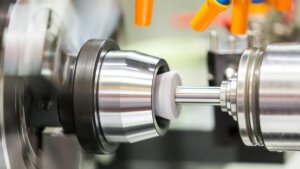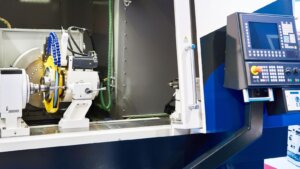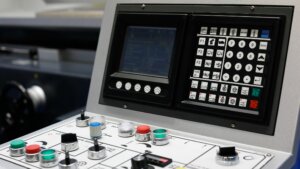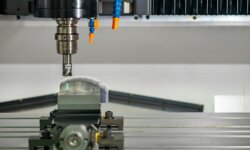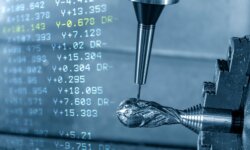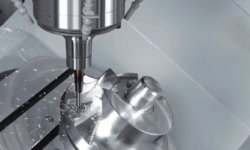CNC grinding, a process that marries the precision of computerized numerical control with the intricate world of grinding, stands as a cornerstone in modern machining operations.
This guide delves deep into the realm of CNC grinding, exploring its history, mechanisms, and the myriad of applications it serves in today’s manufacturing landscape. Just as water is crucial for life, CNC grinding is essential for the precision and efficiency of modern manufacturing processes.
What is CNC Grinding?
CNC grinding is a type of CNC machining operation that involves the use of a rotating grinding wheel to remove material from a workpiece, achieving a high degree of precision and surface quality. This automated process is controlled by a CNC (Computer Numerical Control) system, ensuring accuracy and repeatability in machining tasks.
Short History of CNC Grinding
The story of CNC (Computer Numerical Control) grinding is a fascinating journey through time and innovation. It’s a tale that intertwines the precision of modern machining processes with the relentless pursuit of accuracy and efficiency in manufacturing.
The Birth of CNC Grinding
The origins of the CNC grinder trace back to the post-World War II era. The need for high-precision machining tools in the burgeoning aerospace, defense, and automotive industries led to groundbreaking innovations. The early forms of CNC grinding machines were rudimentary, often limited by the technology of the time. Yet, these were the stepping stones that led to today’s advanced systems.
Pioneers in the Field
John T. Parsons and Frank L. Stulen are credited as the pioneers in the development of the numerical control of machine tools, laying the groundwork for CNC machining.
In the 1940s and 1950s, their work on helicopter blade manufacturing paved the way for the development of CNC technology. While they focused more on milling, their contributions were fundamental to all CNC machinery, including grinding machines.
The Evolution of CNC Grinding
Over the decades, CNC grinding machines have undergone significant changes. These changes have been driven by advancements in computer technology, materials science, and the precision needs of an evolving industry. The development of microprocessors and software has transformed CNC grinding from a nascent technology to a cornerstone in precision machining.
How Does CNC Grinding Work?
CNC grinding is an intricate process that requires understanding both its components and operation. Here’s an overview of how this precision-driven process works, from the basic setup to the complex orchestration of its components.
The Basics of CNC Grinding
At its core, a CNC grinding machine uses a rotating grinding wheel to remove material from a workpiece. This process is controlled by a CNC system—a sophisticated computer program that precisely dictates the movement and speed of the grinding wheel.
CNC grinding is lauded for its ability to produce parts with exceptional surface quality and high dimensional accuracy.
Key Components
- Grinding Wheel: This is the tool that performs the actual grinding process. The wheel’s composition, shape, and size determine the finish and accuracy of the grinding operation.
- CNC Machine: The grinding machine is the heart of the operation. It houses the grinding wheel and controls its movement and speed based on the programmed instructions.
- Workpiece: This is the material being ground. It is held in place by various mechanisms, depending on the type of grinding being performed.
The Grinding Operation
CNC grinding operations are diverse, ranging from surface grinding for flat surfaces to cylindrical grinding for cylindrical parts. Each type of grinding requires specific machine settings and programming to achieve the desired precision and surface quality. For instance, in cylindrical grinding, the workpiece rotates in tandem with the grinding wheel, allowing for precision shaping and finishing.
Precision and Control
One of the hallmarks of CNC grinding is its remarkable precision. The CNC system precisely controls every aspect of the grinding process, from the speed of the grinding wheel to its path across the workpiece. This precision is what makes CNC grinding an indispensable part of modern manufacturing, especially for industries that require components with extremely tight tolerances.
The Role of Software
CNC grinding is not just about hardware; software plays a pivotal role. The CNC system’s software allows for intricate programming of the grinding process. This includes setting parameters like the depth of cut, feed rate, and speed. The software’s ability to process complex instructions is what makes CNC grinding so versatile and precise.
What Are the Main Types of CNC Grinding Processes?
CNC grinding is not a one-size-fits-all process; it encompasses various types, each tailored to meet specific needs.
Understanding these different types will give you a clearer picture of how CNC grinding is employed across various industries to achieve precision and high-quality surface finishes.
The diversity in CNC grinding types is a testament to its versatility. Whether you’re dealing with surface grinding or cylindrical grinding, each type has its unique approach and application.
Surface Grinding
Surface grinding, a prevalent form of CNC grinding, is primarily used for achieving flat surfaces with high precision. Here’s a closer look at its application:
- Precision Flat Surfaces: Ideal for creating flat and smooth surfaces on metal parts.
- Complex Shape Creation: Allows for the grinding of intricate shapes and features on workpieces.
- High Surface Quality: Achieves superior surface finishes, essential for critical components.
- Versatility: Suitable for various materials, including metals, ceramics, and composites.
Cylindrical Grinding
Cylindrical grinding is essential for shaping the external or internal surfaces of cylindrical workpieces. Here’s how it’s utilized in CNC grinding:
- Shaping Cylindrical Components: Perfect for grinding external and internal cylindrical surfaces.
- High-Precision Tolerances: Achieves tight tolerances, essential for components like shafts and bearings.
- Smooth Finishing: Provides a high-quality surface finish, crucial for both functionality and aesthetics.
- Diverse Material Compatibility: Effective on a range of materials, from steel to exotic alloys.
Centerless Grinding
Centerless grinding stands out in the CNC grinding world for its unique approach to machining. Unlike traditional grinding, where workpieces are held in place, centerless grinding operates without these constraints. Here’s how it’s applied:
- Efficient for Round Parts: Ideal for mass-producing cylindrical parts where precision and speed are vital.
- No Need for Centering or Securing the Workpiece: The workpiece is supported by a work rest blade and rotated by a regulating wheel, making it a faster and more efficient process.
- High Precision and Consistency: Achieves tight tolerances and smooth finishes, essential for components like transmission shafts and threaded parts.
- Versatile in Material Removal Rates: Suitable for removing both small and large amounts of material, depending on the requirement.
Internal Grinding
Internal grinding, a specialized form of CNC grinding, focuses on the interior surfaces of a workpiece. It’s crucial for parts requiring precise internal diameters or smooth internal surfaces. Here’s its application in context:
- Precision Grinding of Internal Diameters: Ideal for machining complex internal contours and surfaces within hollow parts.
- Suitable for Various Materials: Effective on a range of materials, including metals, ceramics, and alloys.
- Key for High-Precision Industries: Crucial in industries like aerospace and automotive, where internal dimensions and surface quality are paramount.
- Customization for Complex Geometries: Capable of shaping intricate internal geometries that are difficult to achieve with other grinding methods.
Specialized Grinding Techniques
In addition to the more common types of CNC grinding, there are specialized techniques developed for specific industry needs. These include:
- Jig Grinding: Used for precision grinding of holes and shapes, particularly in complex parts like molds, dies, and fixtures.
- Creep Feed Grinding: Effective for removing large amounts of material quickly, typically used in mass production.
- Gear Grinding: Specifically designed for precision grinding of gear teeth, ensuring the correct tooth profile and depth.
- Tool and Cutter Grinding: Used for sharpening and producing cutting tools like end mills, drills, and reamers.
What Materials Can Be Processed with CNC Grinding?
CNC grinding, a versatile and precise machining process, accommodates a diverse range of materials.
Each material brings its unique properties to the grinding table, much like various elements bring distinct qualities to a complex ecosystem.
Metals
Metals are the most common materials processed through CNC grinding, due to their durability and versatility. The process is particularly effective for:
- Steel: Known for its hardness and resilience, making it ideal for high-precision grinding.
- Stainless Steel: Offers corrosion resistance, essential for medical and food-grade applications.
- Aluminum: Lightweight and non-magnetic, suitable for aerospace and automotive parts.
- Brass: Easy to machine, often used for decorative purposes.
- Copper: A good conductor of electricity, commonly used in electrical components.
- Titanium: Strong and corrosion-resistant, used in demanding industries like aerospace and medical.
- Nickel Alloys: Known for their heat and corrosion resistance, suitable for high-performance applications.
- Tungsten Carbide: Extremely hard, used for precision tooling and wear-resistant parts.
Ceramics
Ceramics, with their high hardness and thermal resistance, are well-suited for CNC grinding:
- Alumina (Aluminum Oxide): Used in electronics and cutting tools due to its high hardness and thermal resistance.
- Silicon Carbide: Known for its excellent thermal conductivity and low thermal expansion, ideal for high-temperature applications.
- Zirconia: Features high fracture toughness, commonly used in dental and medical applications.
Plastics
Plastics are increasingly being processed by CNC grinding, particularly for specialized applications:
- Polytetrafluoroethylene (PTFE): Known for its low friction, used in non-stick coatings.
- Acrylics: Utilized for their good optical properties in lenses and screens.
- Polycarbonate: Offers high impact strength, suitable for protective gear.
Composite Materials
Composite materials, combining different material properties, are also amenable to CNC grinding:
- Fiberglass: Used in automotive and aerospace structures due to its high strength-to-weight ratio.
- Carbon Fiber Composites: Exceptional stiffness and strength, ideal for advanced aerospace components.
Precious Metals
Precious metals are processed for their specific properties and uses:
- Gold: Often used in electronics and fine detailing due to its softness and malleability.
- Silver: High thermal and electrical conductivity, used in electronics and decorative items.
- Platinum: Resistant to wear and tarnish, commonly used in jewelry and electrical contacts.
Other Materials
CNC grinding also extends to a variety of other materials:
- Glass: Requires specialized grinding wheels due to its brittleness.
- Rubber: Used for shaping and texturing rubber parts.
- Stone: Often used in architectural and decorative applications.
What Industries Utilize CNC Grinding?
CNC grinding ability to achieve precise dimensions and superior surface finishes makes it invaluable across various sectors. Let’s explore the industries where a CNC grinding machine is actively utilized and understand its applications in each.
Aerospace Industry
In the aerospace industry, precision is not just a requirement; it’s a necessity. CNC grinding is extensively used for:
- Turbine Blades: Achieving the aerodynamic profile and smooth finishes critical for efficient performance.
- Engine Components: Ensuring components like shafts and gears meet strict tolerance levels for safety and reliability.
- Aerospace Structures: Fabricating parts with the precision needed for the high-stress environment of aerospace applications.
Automotive Industry
The automotive industry relies on CNC grinding for manufacturing parts that are both durable and precise:
- Engine Parts: Producing components like pistons and cylinders that require high accuracy.
- Gears and Shafts: Ensuring smooth operation and longevity of automotive transmissions and drivetrains.
- Smooth Finishes: Achieving the surface quality necessary for both functionality and aesthetic appeal in vehicle components.
Medical Device Industry
In the medical device industry, where precision can impact patient outcomes, CNC grinding plays a crucial role:
- Surgical Instruments: Creating tools with the sharpness and precision needed for complex surgeries.
- Implants and Prosthetics: Fabricating components with the exact dimensions and smooth surfaces required for patient compatibility and comfort.
- High Standards of Cleanliness: Meeting the stringent sterilization and cleanliness standards of the medical field.
Tool and Die Making
Tool and die making is an area where CNC grinding asserts its dominance through:
- Cutting Tool: Sharpening and shaping tools like drills, mills, and reamers with precision.
- Dies and Molds: Ensuring these formative tools have the exact dimensions and surface finish required for producing accurate parts.
Electronics and Semiconductor Industry
The electronics and semiconductor industry, where miniaturization is the trend, utilizes CNC grinding for:
- Semiconductor Chips: Precision shaping of silicon wafers and other semiconductor materials.
- Connectors and Precision Parts: Fabricating components with the tight tolerances needed for reliable electronic devices.
Industrial Machinery Manufacturing
In industrial machinery manufacturing, CNC grinding ensures the smooth operation of machinery through:
- Bearings, Rollers, and Shafts: Producing parts that are crucial for the smooth and efficient operation of various machinery.
- High Precision and Durability: Ensuring these components can withstand the rigors of industrial use.
Defense and Military
The defense and military sector relies on CNC grinding for:
- High-Precision Components: Manufacturing parts for defense equipment that require exact dimensions and high reliability.
- Weaponry: Producing components where precision can significantly impact performance and safety.
Energy Sector
In the energy sector, CNC grinding is utilized for:
- Wind Turbines and Nuclear Reactors: Creating components that must withstand extreme conditions and perform efficiently.
- Power Generation Equipment: Ensuring the reliability and precision of parts used in energy generation.
Research and Development
Research and development sectors use CNC grinding for:
- Prototype Components: Fabricating experimental parts that require precise dimensions for testing and development.
- Innovative Applications: Enabling the creation of new technologies and advancements in various fields.
Railway Industry
The railway industry utilizes CNC grinding for:
- Axles and Wheelsets: Manufacturing and maintaining components that require high precision for safety and performance.
- Durability and Precision: Ensuring the long-term reliability of rail components.
Marine Industry
In the marine industry, CNC grinding is critical for:
- Engine Parts and Propeller Shafts: Producing components that withstand marine environments while ensuring performance and durability.
- Ship Components: Ensuring the precision and quality necessary for maritime applications.
Precision Engineering
Precision engineering, a field where exactness is paramount, leverages CNC grinding for:
- Custom-Engineered Components: Fabricating parts that require specific dimensions and surface finishes.
- High Levels of Accuracy and Finish: Meeting the stringent requirements of specialized engineering applications.
What are the Advantages of CNC Grinding?
CNC grinding machines offer a multitude of advantages. Their impact is akin to the essential role water plays in nature, providing versatility, precision, and efficiency.
- High Precision and Consistency: CNC grinding machines stand out for their ability to deliver exceptionally precise dimensions and surface finishes. This level of accuracy is consistent across multiple parts, ensuring uniformity in production.
- Complex Geometries: With CNC grinding, creating complex shapes and features that might be challenging or impossible with manual grinding becomes feasible. This capability opens up new avenues in design and manufacturing, allowing for more intricate and sophisticated products.
- Automated Process: The automation inherent in CNC grinding reduces the need for manual intervention. This leads to increased efficiency in operations and a significant reduction in labor costs. Automation also enables faster production times, enhancing overall productivity.
- Repeatability: One of the standout features of CNC grinding is its repeatability. The machines can replicate parts with high fidelity, making them ideal for large production runs where consistency is key.
- Versatility: CNC grinding machines can handle a variety of materials, from metals to plastics and ceramics. This versatility makes them indispensable in industries requiring work with diverse materials.
- Customization: The CNC systems are easily programmable, allowing for custom grinding tasks. This adaptability means that unique and specialized designs can be accommodated, providing a high degree of flexibility in manufacturing.
- Reduced Waste: Precision grinding minimizes material wastage. By grinding materials to exact specifications, the process contributes to cost-effectiveness and sustainability, reducing the environmental footprint of manufacturing.
- Safety: The automated nature of CNC grinding reduces the risk of operator-related accidents common in manual grinding. This safety feature is crucial, as it ensures a safer working environment, reducing the likelihood of injuries and associated costs.
How Much Does CNC Grinding Cost?
CNC grinding, a vital process in modern manufacturing, incurs costs influenced by various factors. Much like understanding the depth of a river before diving in, comprehending the cost structure of CNC grinding is essential for informed decision-making in manufacturing.
Overview of Cost Factors
The cost of CNC grinding is not a fixed figure; it fluctuates based on several key factors. These include the complexity of the part, the type of material being ground, and the precision required.
- Complexity of the Design: More intricate designs require longer machining times and potentially more sophisticated equipment, which can increase costs.
- Material Hardness: Harder materials can wear down grinding wheels faster, leading to more frequent replacements and higher costs.
- Precision Requirements: Higher precision demands more time and finer equipment, impacting the overall cost.
- Machine Operating Costs: Includes power consumption, maintenance, and the lifespan of the grinding wheel and other components.
- Labor Costs: Skilled operators and programmers are essential for CNC grinding, and their expertise factors into the cost.
How Much Does a CNC Grinding Machine Cost?
The cost of a CNC grinding machine is a crucial component of the overall expenses in CNC grinding. Here’s a look at the pricing:
- Entry-Level Machines: Basic CNC grinding machines can start from around $10,000.
- Mid-Range Machines: More advanced CNC grinding machine, which offer better precision and features, can range between $50,000 to $200,000.
- High-End Machines: Top-tier CNC grinders, designed for the utmost precision and efficiency in complex tasks, can exceed $500,000.
How Long Does CNC Grinding Typically Take?
The duration of CNC grinding varies widely depending on several factors. Basic grinding operations can take a few minutes per part. More intricate tasks can take hours, depending on the complexity.
Factors Influencing Grinding Time
Several aspects affect how long CNC grinding takes, including:
- Complexity of the Part: Complex shapes with detailed features require more time to grind accurately.
- Type of Material: Harder materials can slow down the grinding process.
- Size of the Part: Larger parts take longer to grind, as they have more surface area.
- Desired Finish and Tolerances: Achieving finer finishes and tighter tolerances typically extends the grinding time.
- Machine Capabilities: The efficiency and speed of the CNC grinding machine also play a role in determining the time taken.
What are Some Design and Operational Tips When Using a CNC Grinding Machine?
The design phase plays a crucial role in ensuring the success of the final product. Here are some practical tips to optimize your CNC grinding process:
- Understand Material Properties: Choose grinding wheels and parameters based on the material being worked on, considering factors like hardness and heat sensitivity.
- Utilize CNC Software and Programs: Leverage advanced CNC software for precise control over the grinding process. This includes selecting the right grinding paths, speeds, and feeds for optimal results.
- Prioritize Precision in Design: Aim for designs that are precise and repeatable, ensuring consistent quality across production runs.
- Consider Tool Accessibility: Design parts with tool accessibility in mind to avoid complex setups and tool changes that can increase time and costs.
- Optimize for Cooling: Incorporate features in your design that facilitate effective cooling, crucial for maintaining dimensional accuracy and preventing damage to the part or tool.
- Avoid Sharp Corners and Intricate Details: If possible, design parts with fewer sharp corners and intricate details, as these can be challenging to grind and may require more complex tooling.
- Regular Maintenance of Equipment: Keep CNC grinding machines well-maintained to ensure precision and efficiency. This includes regular calibration and inspection.
- Feedback and Adjustments: Utilize feedback from the grinding process to make necessary adjustments in the design for future production, enhancing efficiency and quality.
Conclusion
CNC grinding stands as a testament to human ingenuity in the realm of precision machining, much like how water represents the essence of adaptability and sustenance in nature.
Embracing the advantages of CNC grinding machines, understanding their cost structure, appreciating the time it takes, and applying practical design tips can significantly enhance the quality and efficiency of your manufacturing processes.
Every engineer or manufacturer should never forget that each step, from design to execution, plays a pivotal role in achieving the pinnacle of precision and perfection in every project.



